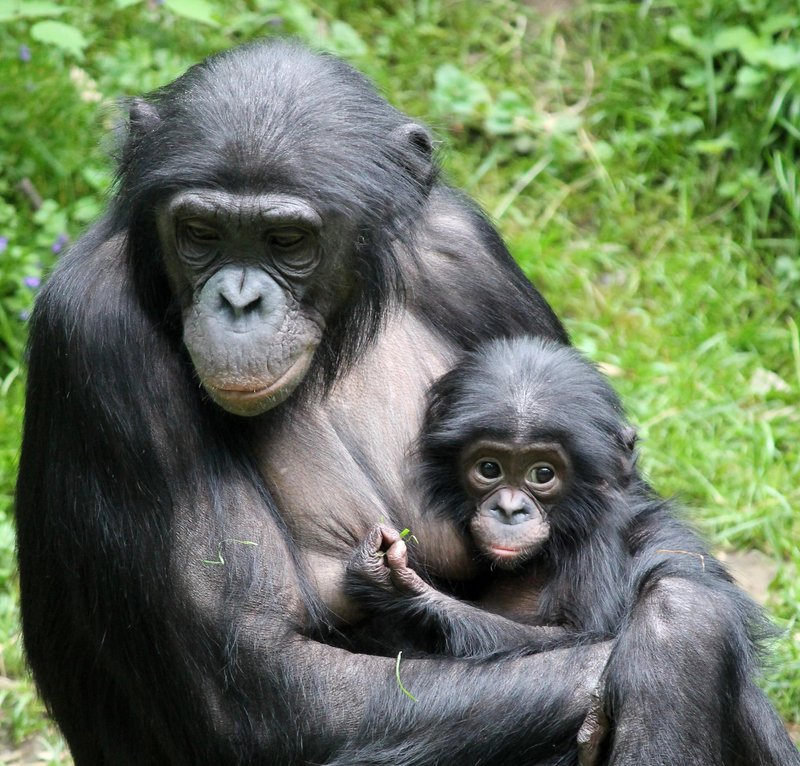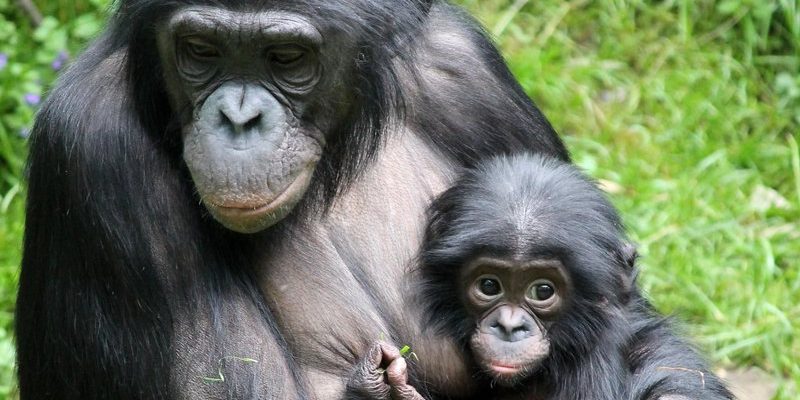
Bonobos are known for their playful behavior and deep emotional bonds. Unlike their more aggressive chimpanzee cousins, they lean into peace, using social interactions and affection to solve conflicts. This approach extends to how they nurture their offspring, offering a unique perspective on parenting that many humans could learn from. Let’s take a closer look at how bonobos navigate the complexities of raising their young while living in the lush forests of the Democratic Republic of the Congo.
The Bonobo Family Structure
Bonobos live in matriarchal societies, meaning females hold the highest social status. This structure not only fosters a sense of security for the young but also creates a nurturing environment. In these groups, mothers are the central figures, often forming close bonds with their offspring.
Female bonobos typically give birth to a single infant every 4 to 5 years, which means each young bonobo gets a lot of attention. Mothers are incredibly involved in their child’s growth, providing not just food and safety, but also emotional support. The strong maternal instincts seen in bonobo moms help shape a child’s social skills and emotional intelligence. Honestly, watching how these little ones learn through observation and interaction is just heartwarming.
You might be wondering how this family dynamic plays out in day-to-day life. In bonobo communities, males often rely on their mothers for support and guidance, helping to maintain harmony. The presence of multiple generations within the group allows young bonobos to learn everything from foraging techniques to complex social behaviors just by being around their moms and other relatives.
Bonding Through Play
Play is a crucial part of a bonobo’s upbringing. Young bonobos engage in playful interactions that help them learn important life skills. Think of it as their version of school—except it takes place in the trees and is filled with fun and laughter.
Playful activities among bonobos often include chasing, wrestling, and swinging from branches. These interactions are more than just fun; they help develop physical coordination and social skills. For example, when young bonobos wrestle, they learn about boundaries, cooperation, and even negotiation. It’s a fantastic way for them to build confidence and friendships.
Interestingly, play isn’t just limited to the young. Adult bonobos often join in, reinforcing social bonds and teaching important lessons through their interactions. Here’s the thing: every playful encounter is an opportunity for learning, making play an essential component of their upbringing.
Feeding and Nurturing
Nutrition is vital for the healthy growth of bonobo infants. Mothers often carry their babies on their bellies while they forage for food, ensuring that their young ones stay fed and safe. Bonobos primarily eat fruits but also enjoy leaves, seeds, and sometimes small insects.
As these little ones grow, they start to learn about different food sources by watching their mothers. Young bonobos mimic their moms, trying out new foods under their watchful eyes. This method of learning helps them develop foraging skills that are crucial for survival in the wild. It’s not just about survival, though—this shared experience nurtures bonding between the mother and child, making them closer over shared meals.
The way bonobo mothers care for their young reflects a deep understanding of their needs. In harsh weather or during periods of scarcity, mothers will prioritize their offspring, often slowing down their own eating to ensure their babies get the nutrition they need. This instinctive nurturing not only helps the young survive but also strengthens the emotional ties within the group.
Social Learning and Observation
Bonobos are keen observers, and much of their learning comes from watching others. You might say they have a very hands-on learning style. As youngsters, they closely follow their mothers and other group members, absorbing social cues and behavior.
For instance, when a young bonobo sees an adult use tools or forage for food, it’s not just a random event—it’s a lesson in action. Over time, these observations help them develop problem-solving skills. Imagine learning how to cook by watching a master chef rather than just reading a recipe—that’s how bonobos approach learning.
This type of social learning is crucial for their survival. Bonobos navigate a rich social environment where understanding relationships and hierarchies can mean the difference between thriving or struggling. By observing and interacting, young bonobos become adept at reading social situations, which is essential when they’re older.
Emotional Development and Support
One of the most remarkable things about bonobo parenting is the emotional support they provide. Bonobo mothers are not only caregivers but also emotional anchors for their young. They comfort their infants through grooming, cuddling, and vocalizations.
This nurturing approach helps the young bonobos develop secure attachments, which is crucial for their emotional health. Research shows that animals with strong emotional bonds tend to be more resilient and better at handling stress, and bonobos are no exception. When faced with challenges, young bonobos often seek comfort from their mothers, highlighting the importance of these emotional connections.
Moreover, the community plays a vital role in emotional development. Other group members often interact with the young bonobos, offering additional support and encouragement. This collective nurturing creates a safety net that helps them feel secure and fosters a sense of belonging.
Independence and Maturation
As bonobos grow, their path toward independence is gradual yet significant. Around the age of 4, young bonobos start exploring their surroundings more on their own, but they still rely on the group for guidance and support. It’s like learning to ride a bike—you might start with training wheels but eventually learn to balance on your own.
During this maturation process, young bonobos continue to observe their mothers and other adults, gradually taking on tasks like foraging and grooming themselves. They learn how to navigate social dynamics, which is crucial for forming relationships later in life.
As they mature, bonobos will often test boundaries, leading to experiences that teach them about the importance of social cohesion. This journey to independence blends freedom and social learning, allowing each bonobo to develop its personality while staying connected to its roots.
The Impact of Environment on Bonobo Parenting
The environment plays a significant role in how bonobos raise their young. Living in dense tropical forests, bonobos rely on their surroundings for food, shelter, and social interaction. Environmental factors, such as food availability and habitat stability, influence parenting strategies.
When resources are abundant, mothers can afford to spend more time nurturing their young and teaching them essential skills. However, in times of scarcity, the dynamics shift. Mothers may need to prioritize foraging over play, adjusting their parenting techniques based on the situation.
Moreover, habitat destruction and human activity pose significant threats to bonobos in the wild. As their environment changes, so too does their ability to raise healthy young. Conservation efforts are vital for ensuring that these incredible primates can continue their unique parenting practices for generations to come.
In conclusion, bonobos offer a unique insight into parenting in the wild. Their focus on nurturing, emotional bonding, and community support provides a rich tapestry of how young ones grow and learn. As we observe these fascinating creatures, we can reflect on the values of empathy, cooperation, and kindness—qualities that resonate not just in the wild, but also in our lives as humans. Watching them navigate their journey reminds us of the importance of connection and community in raising the next generation.

